In brief: Though once created by volcanic forces, riven by human passions and greed, Easter Island now offers a stunning historical legacy and a Pacific charm.
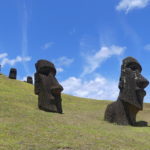
Easter Island, or Rapa Nui, or Isla de Pascua, is a dot of land in the middle of the Pacific, five hours by air from anywhere else. It exists in two very distinct, but mutually involved, time frames. There is, of course, the present as a pleasant Pacific island though one with somewhat colder waters around it than most. And the past, with its remarkable statuary and archeological record speaking from an ancestral epoch.
The present
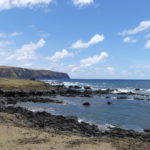
As to the present, most visitors do come to see the things of the past. If they’re smart, they leave enough time to discover its current pleasures, the plentiful physical charms as well as the workaday life of its residents.
Easter Island was formed into a triangle by lava flows from three large volcanos that erupted over a long span of years. The land in between is mostly flat, though a few stray cones pop up here and there.
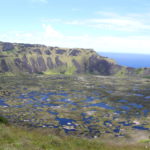
The most interesting volcano, Rano Kau, dominates the southwest knob of the island, with a deep crater that became a unique biodiverse wetlands naturally protected from human harm. On Rano Kau’s far right edge, we could also visit a landmark of the past. On a narrow band of land between the crater and the steep cliffs of the sea, archeologists have re-created a culturally important priestly village from centuries ago.
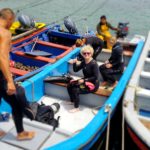
So, there are volcanoes to climb, reserve territories around them to walk, 40 kilometers or more of plains to cycle, a few sun-soaked sand beaches along the north, and other spots to launch yourself off-shore with a snorkel or surfboard.
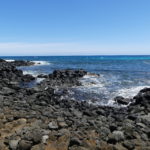
And just about all of this largely within sight of the azure sea, and a shore-line featuring rugged bays and volcanic cliffs.
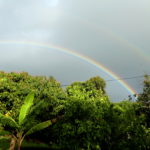
Rains and tropical storms are frequent, often coming and going throughout the day. Despite one torrential day, which brought the surprise of a double rainbow, we mostly experienced sunny skies with wandering puffy clouds.

The island is surrounded by coral reefs, not as colorful as elsewhere or abundant in tropical fish, but full of fantastic shapes – and with one very distinctive, encrusted underwater figure of a moai. It’s not a real one, but it looks good enough, a stand-in for a larger statue that was lost in the deep sea after the cable being used to haul it up onto land failed. The protected bay just to the north of Hanga Roa, the only town, is the departure point for diving at the reef, just a few minutes off-shore, where you take one of the boats docked alongside those used by the fishermen of the island.

Fishing has been a principal food source for the population ever since the first Polynesian people arrived about 1200 years ago. Fishers still hawk their catch every day on main street (and presumably in local fisheries).
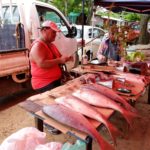
This street’s three or four blocks offer small groceries and other stores for the locals, as well as car rentals, guide services and handicrafts for the tourists.
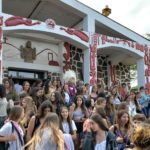
Since the 18th century, various European powers have occupied and harmed the island, bringing disease and enslaving the population. The Spaniards eventually controlled the land, with the island becoming part of Chile. None of the old religious practice survived, except perhaps in decorative touches. And, though other religions may have churches here, twice on Sunday the plain interior of the island’s Catholic church fills with locals – and curious tourists – for a service conducted in Spanish, with music in the native language. Dressed in richly colored robes and a feathered headdress, the priest stands out, even amid visiting groups of Chilean youth. His vestments befit the front of the elaborately decorated façade of the church.
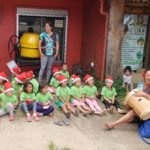
And the deep mid-summer, in the vicinity of the equator, with a temperature of 26 or so degrees C – the low 80s F – under a hot sun, there is still celebration of Christmas, as a school group dresses as little elves demonstrated when they entertained passers-by on main street with carols in the native language.
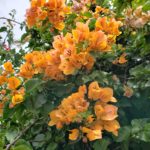
Outsiders transformed the island botanically as well. When the Europeans arrived, palm trees covered the island. Most are gone except where they have been replanted or protected. Now so much of the plant-life comes from elsewhere. But, wherever they come from, the flowers abound gloriously.
Tracing the past
And then there’s the past, the reason most visitors come here.
Around 1000 years ago, masterful sailors from Polynesia arrived on Rapa Nui under the leadership of King Hotu Matu’a. They charted direction by the stars and sun, capably detecting signs of land from birdlife, outflows of plant-life and so on.

They maintained their cult of worshiping ancestors, but honored them in a way that made Easter Island unique. They carved huge statues – moai, up to 22 meters (50 feet) tall – out of the softer volcanic rock of the island, or tuff, using only hand-made tools of harder basalt, and erected these on enormous platforms – ahu. At the ahu, which was often adjacent to a village, they buried their dead in back, and ritually recalled their ancestors on the large front terrace – not as gods, but abiding spirits of their relatives. In doing these ceremonies, they hoped to gain good fortune in farming and fishing, as a kind of blessing from past generations.
For over 500 years, the very hierarchical society devoted extensive manpower to building ahu. Over time, wealthier families secured the prime oceanside plots for their ahu and controlled access to ocean fishing. Eventually over-population and increasingly limited resources (food, wood, etc.) led to civil wars. The ahu were destroyed in vengeful attacks. The remains of the platforms and moai still limn the entire coast of the island.
By the time Europeans discovered this little island on one Easter’s day in the 18th century, they found the remnants of the ahus, and all the giant moai toppled, generally face down, as if to shame them. At Vaihu (Hanga Te’e), for example, eight fallen moai lie this way, their faces crushed or noses jammed into the ground. Nearby rolled the red cylinders, or top knots, placed on top of the moai like a hat, but actually intended to resemble the traditional male knotting of the hair atop their heads.
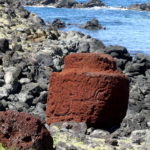
One rolled down to a nearby cove about 50 meters away. Each was originally etched with drawing and figures, as several at Vaihu still showed.
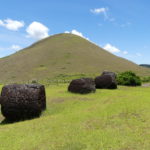
Unlike the volcanic tuff used for the moai, the top-knots mostly came from a rich deposit of the red scoria used to make them at Puna Pau volcano. Here the weighty top-knots were hacked from the mountain, carved into those round shapes, inscribed with figures, and somehow moved to sit atop the moai. As they were in effect wheels, they could be rolled…carefully. Work stopped here after the tribal wars – and the unfinished top-knots were just abandoned. The quarry for tuff is a very different kind of place, as we note later.
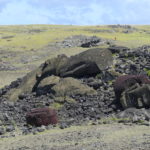
The moai we found face up – like several heads at Aka Hanga – were to us a more poignant memorial to the past. And these toppled figures and ruined ahu are generally what we see today around the island, much as the Europeans found them originally.

They lie like this all over the island, helpless eroding figures like the one we found about twice human size, against the backdrop of its source, one of the island volcanoes.
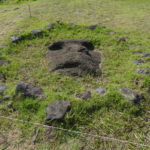
Others have been covered up by dirt and vegetation over time, and regularly unearthed. One such face seemed to come up for air near a broken ahu, evoking both amusement and horror in us.
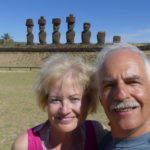
Happily in several sites, however, authentic moai have been restored by dedicated archaeologists to their ahu platforms – once again honoring the ancestors of this island people. You’re not allowed to leave the island without a good selfie in front of one of these restored ahu. We thought we looked pretty good at the popular ahu at Anakena, one of just a few sand beaches on the island – where the moai discreetly turn their backs on the beach bathers.
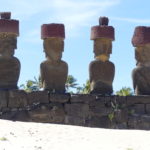
This site is also popular for watching the sunrise behind the moai, a contemporary ritual ceremony. But we found it more interesting as a demonstration of the alterations of ahu during the five centuries of their heyday. Many platforms show multiple levels of re-creation. At one broken site, even we could detect three levels from the past. At Anakena, set below the second moai from the left in lieu of a rectangular block, you can see a sideways face from an earlier stage. The moai here also display their back carvings faintly despite erosive forces over the years.

Still present at the site, though standing apart, was a moai we called gordo – Spanish for fat – because he was one of the more squat ancestors we saw, though quite tall in actuality.
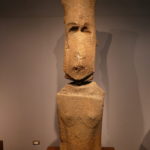
No longer here, but rather at the island museum, stands a human-sized female moai with an interesting story. Thor Heyerdahl found the torso in 1956 at Anakena, brought it back to Norway and spread the story of the island’s old civilization. Thirty-two years later the head was discovered in the ground somewhere at the beach. Eventually Norway returned the torso and reunited the female’s top and bottom in her homeland. Oddly, of the nearly 900 moai found on the island so far, only 10 are identifiably female figures, though many petroglyphs around the island depict female genitals. Draw what conclusion you want from that.
Anakena Beach, looking quite lovely.

There is ongoing debate about all those hollowed eye sockets. As re-created at the shoreline in the town of Hanga Roa, and demonstrated at the island museum, one moai had its eyes completed with white coral cornea and irises of red scoria stone (the material used for the top-knots). But archeologists are not sure whether such eyes were a temporary feature for ceremonies or a more permanent one for all the moai.
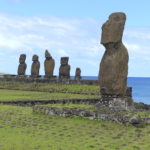
While Anakena draws people for sunrise, Ahu Tahai is the spot for sunsets. It’s far outdistanced in quality and quantity by other restored ahus, but its proximity to most visitors at the northern edge of Hanga Roa town makes it very popular at the end of the day.
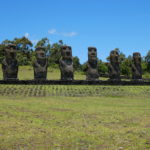
The very first ahu to be reconstructed by archeologists, in 1960, was Ahu Akivi, located close to the northwestern shore. To us, it was also intriguing for demonstrating what we detected as two basic styles of moai faces, which might have come from different periods. All have pursed lips, arms sculpted along the sides and hands placed along a low slung belt. But some have long pointed noses, elongated and prominent chins. Others have squat noses and blunter chins.

The largest rebuilt ahu is Tongariki, at the opposite end of the island. From afar you can’t really tell how large the platform and the moai are. But you are readily dwarfed when you come closer. This is true even in front though visitors can’t step too near them in order to preserve what’s left of the area where ceremonies were performed. And especially true when walking around the back, where we could gaze up at the statues looming above us and see some of their typical carved tattooing that has not worn away. You can get a sense of the size of this ahu and the statues, if you can find Nancy sitting in front of them. Tongariki is truly the most impressive of the restored ahus, with the greatest number of moai and some of the largest (up to 10 meters/33 feet! and 74 metric tons in weight).
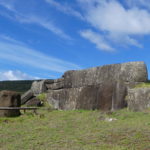
Though so many of the ahu platforms were destroyed, several, like the one at Vinapu, still show sophisticated architectural design with massive support blocks fitted together snugly for strength. Notice how the second and third blocks from the right are locked together with a smaller rectangle. Inca construction techniques in Peru are just like this, though more elaborate, leading some to speculate on interaction between the islanders and pre-colonial South America.
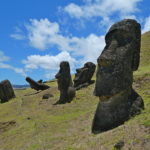
The restored ahus are wondrous, but the most famous moai are the striking statues found at the main quarry for their carving at Rano Raraku volcano – at the eastern end of the island far from the scoria quarry for top-knots.
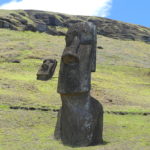
Here the moai were cut from plentiful volcanic tuff (hardened ash), raised up into pits for finishing touches and then hauled to their ahus up to 20 kilometers away, in a method that archeologists can only speculate about. The sloping rockface of the volcano was largely untouched over the last 500 plus years, when moai creation ceased due to the tribal wars.

Near the bottom of the slope, peeking at the ocean nearby, many moai that were ready to move had been toppled like those on all the ahu platforms.

Toward the top of Rano Raraku, however, it’s stunning, as hundreds of moai – ranging from gigante (nearly 22 meters/75 feet tall) to diminutive – still stand, never transported to their intended location. Even those which seem just heads actually have complete torsos, buried over time by accumulating soil.
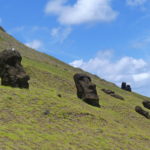
These are the famous ancients of the island, keeping a silent vigil while they wait into eternity for the workers who would have completed them.
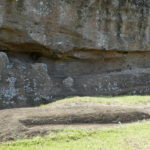
The most revealing of all these are the moai we could see “in process.” At one niche, two moai lay together in different stages of cutting from the rockface when the work on them was abandoned.
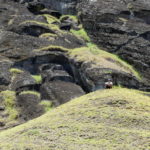
Nearby, another giant had partially emerged from the rock. To us he appeared ready to rise vertically, hoisted up by the workers so the carving could be completed…but still he has rested in his stony coffin for centuries.
(Also, for more pictures from Chile and Argentian, CLICK HERE to view the slideshow at the end of the itinerary page.)


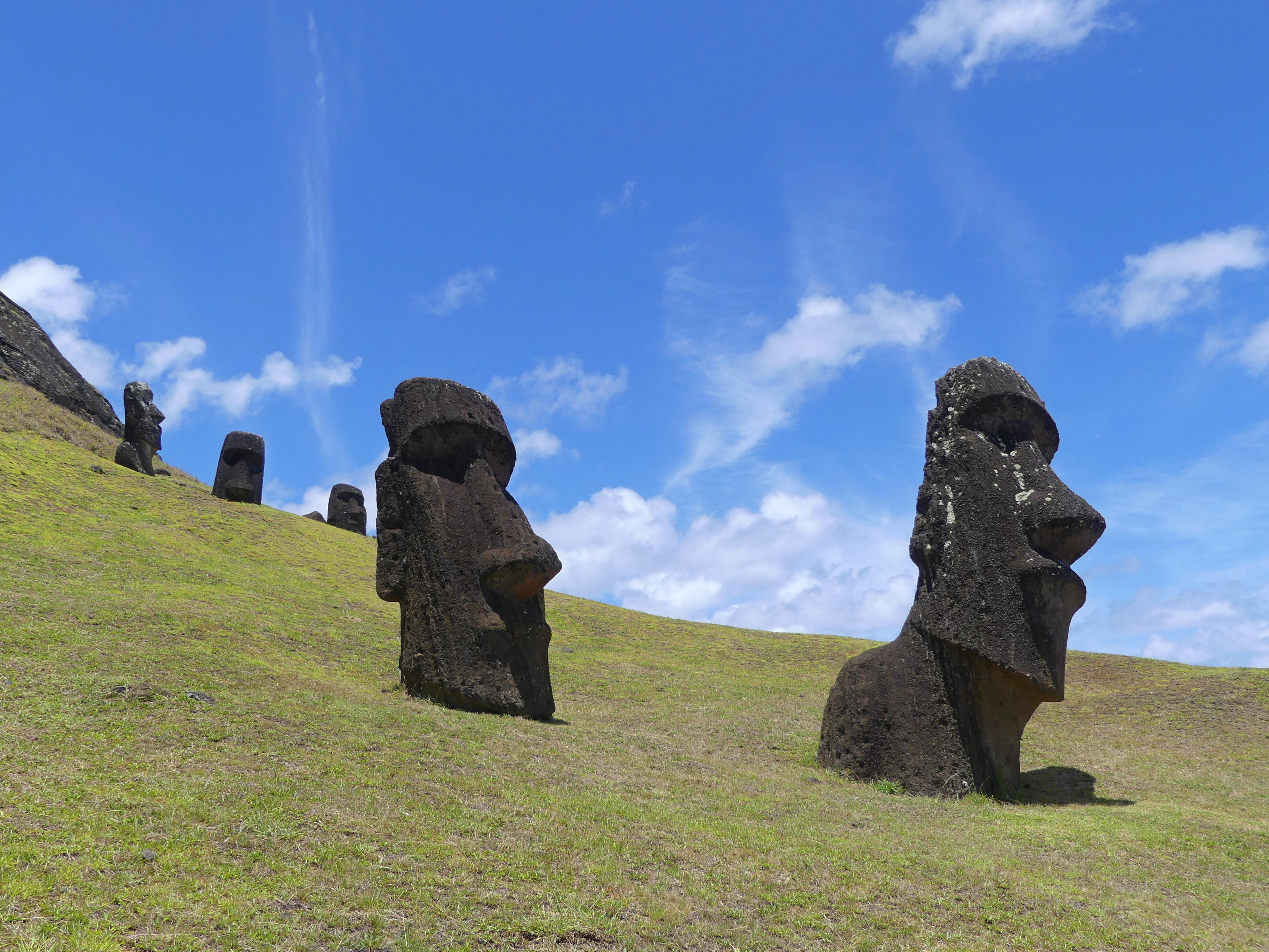
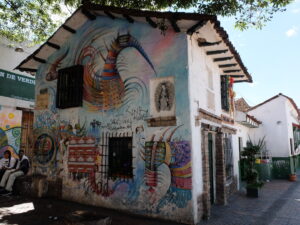
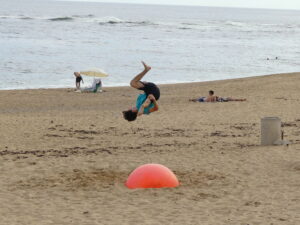
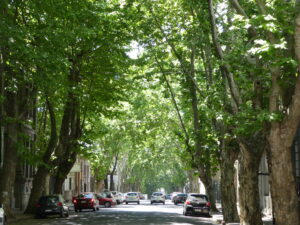
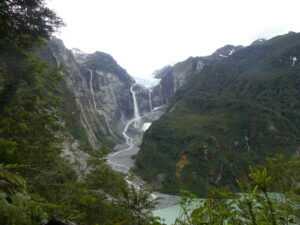
Nice. That’s alot of great Information in a blog! I’ll make sure to bookmark your link before I go anywhere that you have been.